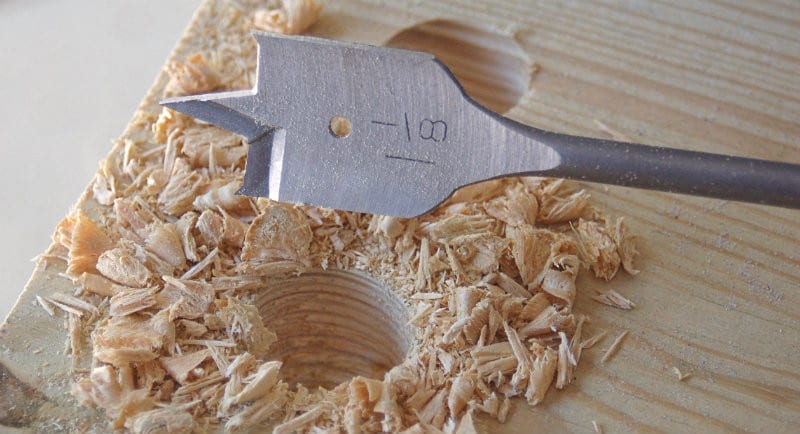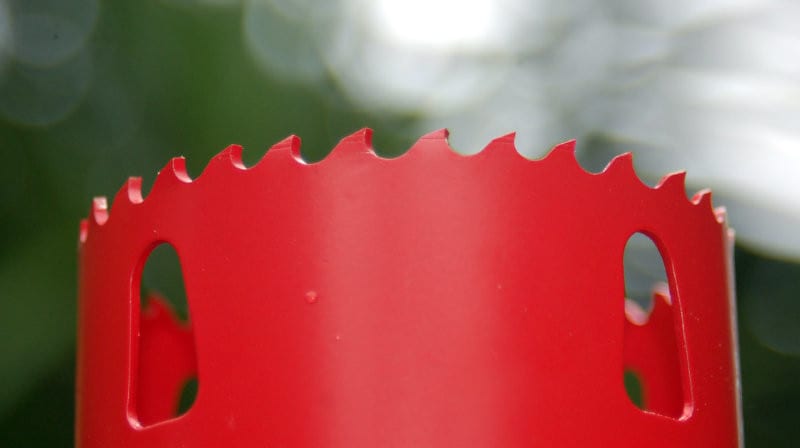What is a Self Feed Bit
We all know that drill bits have their limits when it comes to the size hole you can drill. But what happens when you need to do some larger wood boring?
As a teenager, I decided that I would replace the soft, rotted plywood back deck of our old bass boat. Being relatively ignorant in the ways of tools and working on getting my junior man card, I went to work ripping out the carpet and unscrewing the now very rusty fasteners. Cutting the new board and installing it wasn't too much of a challenge. The problem came when I needed to reinstall the pedestal seat. It was secured by bolts but also sat several inches down through a 2-1/2 inch hole.
Looking back at trying to cut that #$%&*@! hole… what was I thinking? I started with the largest drill bit I had in the center, then tried to work outward with a hand saw. When that didn't work, I tried drilling holes in a circle and connecting the dots with that same dull hand saw. I did eventually get it in there, but it took a heck of a lot longer than it needed to and man, was it UGLY !
Had I known what to look for with spade bits, hole saws, and self-feed bits, I might have spent the afternoon fishing instead of cussing and sweating. Fortunately, I'm wiser now, both in my use of tools and the English language. I'm here to pass on that wisdom along with some help from Milwaukee Tool and their accessories.
Wood Boring with Spade Bits
Hole Diameter Range
Spade bits are going to cover the smallest of your wood boring needs. In fact, the smallest spade bits can be in the same range as a standard wood drill bit. Often called flat boring bits (or variations on that), spade bits come in diameters between 1/4″ and 1-1/2″
Characteristics
Spade bits like Milwaukee Flat Boring Bits have a shape that resembles a paddle. A brad point or threaded tip guides the bit into the wood and through the cut. The sharpened edges of the bit take small slices of wood out and eject them out of the hole. Use spade bits in high-speed mode up to 1″ in diameter and sometimes larger, depending on the design. The largest spade bits typically require low-speed mode to deliver the required torque to the bit.

A good, sharp spade bit lets you apply minimal downforce on your drill to make the cut. You can put additional pressure on it to drill faster, but it isn't necessary. Particularly with larger bits, you'll want to use your drill's side handle if it has one. Today's drills deliver a lot of torque and the bit can bind up causing the drill to twist your wrist or elbow painfully. Some spade bits have a 1/4″ hex shank that you can attach to your impact driver. Spade bits are less expensive than other wood-boring choices.
When to Use Spade Bits
Spade bits like Milwaukee Flat Boring Bits are a great option for cutting holes up to 1″ in wood that doesn't require a fine finish. The breakthrough with a spade bit can be rather unsightly though. If you're going to be leaving one side as the finished surface, drill into that side and let the breakthrough happen on the side you can't see. Once you need to drill holes over an inch (and no longer in high speed with a spade bit), it's time to look at hole saws.

Wood Boring with Hole Saws
Hole Diameter Range
Hole saws come in three basic designs. You typically use diamond grit hole saws in tile, masonry, and glass applications. Bi-metal works well for metal and often finds its way into wood applications. We find carbide-tipped hole cutters efficient for cutting wood. I'll focus on those next. You can typically find this style of wood-boring accessory as small as 1-inch. Conversely, they go all the way up to around 6-inches.
Characteristics
The hole saw consists of two parts: a mandrel and the hole saw. Collectively, we usually referr to the whole thing as a hole saw. The mandrel has a threaded and sometimes a locking coupling built around a drill bit that holds the saw in place. The pilot bit guides the cut. Milwaukee's Big Hawg Hole Cutters actually employ a replaceable spade bit. This reduces the amount of friction against the core to improve the efficiency of the cut.

Because the hole saw as a system is much more complex than a spade bit, they are designed to be able to change hole saws around the same mandrel. This saves money. Hole saws require more torque than spade bits, so the shaft has to be thicker to avoid damage. You'll need a 1/2″ drill for most hole saw systems.
A hole saw works by shredding away just the circumference of the hole rather than chewing out the entire hole like a spade bit or Forstner bit. This results in a solid core or plug you need to remove from the saw at completion.
Carbide vs Bimetal
Look at the teeth of the hole saw to see the difference between carbide-tipped wood boring and bi-metal general-purpose designs. Wood-boring hole saws have 2, 3, or 4 carbide teeth depending on the diameter. You can actually sharpen these teeth when they get dull over time. To give you an idea of sharpening cycles, Milwaukee Big Hawg Hole Cutters can bore up to 600 holes before needing sharpening. Bi-metal hole saws… well, I wouldn't sharpen all those teeth. In fact, we recommend you don't try.

While you can certainly use bi-metal hole saws, they drill up to 10 times slower than carbide-tipped hole saws designed for wood boring. Let the hole saw and drill do the work, and you should be able to drill at high speed most of the time. With larger diameter holes, drop the RPMs (speed) and use that higher drill torque.
When to Use Hole Saws
Hole saws like Milwaukee's Big Hawg Hole Cutters are perfect for wood boring 1″ – 6″ rough-cut holes. It is possible to get bigger hole saws (Milwaukee Big Hawg goes up to 6-1/4″), but you're really straining a typical 1/2″ drill at that point and you'll start needing more specialized equipment.
Like spade bits, hole saws are a rough-cut wood-boring accessory. The breakthrough leaves a rough edge that you need to either sand or cover for finished work. Like spade bits, bore in from the side you intend to use as your finished surface. That hides the breakthrough side from view.

Wood Boring with Self Feed Bits
Hole Diameter Range
Self-feed bits typically handle hole sizes between 1 and 4 5/8-inches. Don't confuse these with Forstner bits that can start as small as 1/4-inch.
Characteristics
Self-feed bits have outer teeth that cut a circumference like hole saws and a radial blade that slices out the core like a spade bit. The result is a cleaner finish that neither style can accomplish on its own. Self-feed bits also have a threaded tip that pulls the bit through the wood. The threaded tips like those on Milwaukee Switchblade Self Feed Bits stick out further than that of a Forstner bit to act as a guide and pull the bit ahead. They are usually favored by contractors who aren't concerned with simply creating a recessed hole.

Most self-feed bits are constructed in a way that lets you sharpen the radial blade. Milwaukee Switchblade Self Feed Bits take it one step further. By adding a removable blade edge, the bits offer just as fine a finish while saving you time. The removable blades, like those from Milwaukee, use hardened steel. You still get a lot of life out of them. Just switch them out when they wear down instead of sharpening them.
Like hole saws, self-feed bits require a lot of torque to chew out a hole. You'll need a 1/2″ drill to accommodate the larger diameter shaft. You'll also want a spare battery nearby if you're using a cordless model. Only with the smallest diameters will you be able to drill in high-speed mode with self-feed bits. You'll make most of your cuts in high torque mode.
When to Use Self Feed Bits
Because self-feed bits fall into a range that is covered by spade bits and hole saws, it can be confusing knowing when to use them. Forstner bits are finish bits that woodworkers and carpenters rely on to make cleaner through holes or recessed holes in wood. Self-feed bits, however, are purely for powering through wood as fast as possible. For applications like under cabinet lighting installations, using a jig and handheld drill are fine with a Forstner bit. When precision is your goal, you'll find most woodworkers turning to a drill press with a Forstner bit and avoiding that self-feed tip. However, general contractors, remodelers, and plumbers will be looking for the threaded tip found on Milwaukee's Switchblade Self Feed Bits.

Source: https://www.protoolreviews.com/wood-boring-spade-bits-hole-saws-forstner-bits/#:~:text=Self%2Dfeed%20bits%20have%20outer,the%20bit%20through%20the%20wood.
0 Response to "What is a Self Feed Bit"
Post a Comment